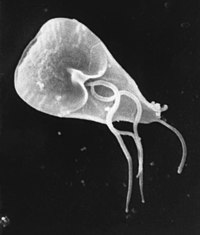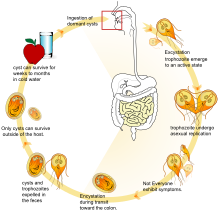Giardia lamblia
| Giardia lamblia | |
|---|---|

| |
| Giardia cell, SEM | |
| Klasifikimi shkencor | |
| Domeni: | |
| Pa klasifikuar: | |
| Filumi: | |
| Rendi: | |
| Familja: | |
| Gjinia: | |
| Lloji: | G. lamblia
|
| Emri binomial | |
| Giardia intestinalis | |
| Sinonimet | |
|
Lamblia intestinalis | |
Giardia lamblia (synonim me Giardia intestinalis, Lamblia intestinalis dhe Giardia duodenalis) është një parazit flagellated protozoan që kolonizon dhe riprodhohet në intestine të vogla, që shkakton giardiasis. Paraziti i giardia njgjitet te epithelium te një ventral adhesive disc, dhe riprodhohet përmes binary fission.[1] Giardiasis nuk përhapet përmes rrugëve të gjakut, nor does it spread to other parts of the gastro-intestinal tract, but remains confined to the lumen of the small intestine.[2] Giardia trophozoites absorb their nutrients from the lumen of the small intestine, and are anaerobes. If the organism is split and stained, it has a very characteristic pattern that resembles a familiar "smiley face" symbol. Chief pathways of human infection include ingestion of untreated sewage, a phenomenon particularly common in many developing countries;[3] contamination of natural waters also occurs in watersheds where intensive grazing occurs.
Ambjenti ku rritet[Redakto | Redakto nëpërmjet kodit]
Giardia infects humans, but is also one of the most common parasites infecting cats, dogs and birds. Mammalian hosts also include cows, beavers, deer, and sheep.
Transmetimi[Redakto | Redakto nëpërmjet kodit]
Cikli i jetës[Redakto | Redakto nëpërmjet kodit]

"[4] This organelle is now termed a mitosome.
Metabolizmin intracellular dhe biokimik[Redakto | Redakto nëpërmjet kodit]
Giardia relies on glucose as its major energy source and breaks glucose down into ethanol, acetate and carbon dioxide.[5] However, it can also use arginine as an energy source.[6] Giardia possesses unique biochemical pathways that suggest that it diverged from other eukaryotes at an early stage in evolution.[6]
B vitamins and bile salts, as well as glucose, are necessary for Giardia to survive, and a low-carbohydrate diet was shown in mice to reduce the number of Giardia organisms present.[7]
Manifestimi i infeksionit[Redakto | Redakto nëpërmjet kodit]


Nomenclature of Giardia species is difficult, as humans and other animals appear to have morphologically identical parasites.
.[8]
People with recurring Giardia infections, particularly those with a lack of the Immunoglobulin A antibody, may develop chronic disease.
Lactase deficiency may develop in an infection with Giardia, however this usually does not persist for more than a few weeks, and a full recovery is the norm[nevojitet citimi].
Some studies have shown that giardiasis should be considered as a cause of vitamin B12 deficiency, this a result of the problems caused within the intestinal absorption system.[9]
Menyra si të ruhemi[Redakto | Redakto nëpërmjet kodit]
Treatment of drinking water for Giardia is ordinarily indicated in wilderness regions in North America,[10][11] although at least four researchers disagree with this statement, including Robert W. Derlet, a professor at the University of California-Davis School of Medicine, Timothy P. Welch and Thomas R. Welsh of Tulane Medical School and the Children's Hospital of Cincinnati respectively, and Robert Rockwell, a widely quoted writer who is an engineer by training.[12][13][14][15]
Boiling suspect water for one minute is the surest method to make water safe to drink and kill disease-causing microorganisms like Giardia lamblia if in doubt about whether water is infected with the Giardia parasite.[16]
Trajtimi dhe diagnoza[Redakto | Redakto nëpërmjet kodit]
Giardia lamblia infection in humans is frequently misdiagnosed. Accurate diagnosis requires an antigen test or, if that is unavailable, an ova and parasite examination of stool. Multiple stool examinations are recommended, since the cysts and trophozoites are not shed consistently. Given the difficult nature of testing to find the infection, including many false negatives, some patients should be treated on the basis of empirical evidence; treating based on symptoms.[17]
Human infection is conventionally treated with metronidazole, tinidazole or nitazoxanide. Although Metronidazole is the current first-line therapy, it is mutagenic in bacteria and carcinogenic in mice, so should be avoided during pregnancy.[8] It has not directly been linked to causing cancer in humans, only in other mammals, therefore appears safe. One of the most common alternative treatments is berberine sulfate (found in Oregon grape root, goldenseal, yellowroot, and various other plants).[nevojitet citimi] Berberine has been shown to have an antimicrobial and an antipyretic effect.[18] Berberine compounds cause uterine stimulation, and so should be avoided in pregnancy. Continuously high dosing of berberine may lead to bradycardia and hypotension in some individuals.[19]
| Drug | Treatment duration | Possible Side Effects |
|---|---|---|
| Metronidazole | 5–7 ditë | Shije metalike; të përzihet; vomiting; dizziness; headache; disulfiram-like effect; neutropenia |
| Tinidazole | Një dozë evetme | Shije metalike; të përzihet; vomiting; belching; dizziness; headache; disulfiram-like effect |
| Nitazoxanide | 3 ditë | Abdominal pain; diarrhea; vomiting; headache; yellow-green discolouration of urine |
| Albendazole | 5 ditë | Dizziness; headache; fever; të përzihet; vomiting; temporary hair loss |
Table adapted from Huang, White.[8]
Trajtimi te kafshët[Redakto | Redakto nëpërmjet kodit]
Mikroskopia[Redakto | Redakto nëpërmjet kodit]

(A) is the cyst imaged by transmission (differential interference contrast), only.
(B) is the cyst wall selectively imaged through use of fluorescent-labelled (TRITC) antibody that is cyst wall specific.
(C) is the cyst imaged through use of carboxy fluorescein diacetate, a viability stain.
(D) is a composite image of (B) and (C).
(E) is a composite image of (A), (B), and (C).
Studime[Redakto | Redakto nëpërmjet kodit]
Genomics[Redakto | Redakto nëpërmjet kodit]
Seven genotypes have been recognised to date (A-G). Of these B is the most widespread. Only types A and B have been shown to be infectious to humans.
Historia[Redakto | Redakto nëpërmjet kodit]
Referime[Redakto | Redakto nëpërmjet kodit]
- ^ Oxford textbook of Medicine, Fourth Edition, Volume 1 (2003) Oxford University Press pp.759-760 ISBN 0-19-262922-0
- ^ Harrison's Internal Medicine, Harrison's Online Chapter 199 Protozoal intestinal infections and trochomoniasis
- ^ C.Michael Hogan. 2010. Water pollution. Encyclopedia of Earth. eds. Mark McGinley and C. Cleveland. National Council for Science and the Environment. Washington DC.
- ^ Tovar J; León-Avila G; Sánchez LB; etj. (2003). "Mitochondrial remnant organelles of Giardia function in iron-sulphur protein maturation". Nature. 426 (6963): 172–6. doi:10.1038/nature01945. PMID 14614504.
{{cite journal}}: Mungon ose është bosh parametri|language=(Ndihmë!) - ^ "Giardia - MicrobeWiki". Microbewiki.kenyon.edu. Marrë më 2010-07-29.
{{cite web}}: Mungon ose është bosh parametri|language=(Ndihmë!) - ^ a b Brown DM, Upcroft JA, Edwards MR, Upcroft P (1998). "Anaerobic bacterial metabolism in the ancient eukaryote Giardia duodenalis". International Journal for Parasitology. 28 (1): 149–64. doi:10.1016/S0020-7519(97)00172-0. PMID 9504342.
{{cite journal}}: Mungon ose është bosh parametri|language=(Ndihmë!)Mirëmbajtja CS1: Emra të shumëfishtë: lista e autorëve (lidhja)[lidhje e vdekur][lidhje e vdekur] - ^ Erlandsen; Meyer (1984). Giardia and Giardiasis. New York: Plenum Press. ISBN 0306415399.
{{cite book}}: Mungon ose është bosh parametri|language=(Ndihmë!)Stampa:Page needed - ^ a b c Gabim referencash: Etiketë
<ref>e pavlefshme; asnjë tekst nuk u dha për refs e quajturaHuang - ^ Cordingley FT, Crawford GP (1986). "Giardia infection causes vitamin B12 deficiency". Australian and New Zealand Journal of Medicine. 16 (1): 78–9. doi:10.1111/j.1445-5994.1986.tb01127.x. PMID 3458451.
{{cite journal}}: Mungon ose është bosh parametri|language=(Ndihmë!) - ^ Betancourt, WQ; Rose, JB (2004). "Drinking water treatment processes for removal of Cryptosporidium and Giardia". Veterinary parasitology. 126 (1–2): 219–34. doi:10.1016/j.vetpar.2004.09.002. PMID 15567586.
{{cite journal}}: Mungon ose është bosh parametri|language=(Ndihmë!) - ^ Exner, M; Gornik, V (2004). "Parasitic zoonoses transmitted by drinking water. Giardiasis and cryptosporidiosis". Bundesgesundheitsblatt, Gesundheitsforschung, Gesundheitsschutz. 47 (7): 698–704. doi:10.1007/s00103-004-0863-y. PMID 15254826.
{{cite journal}}: Mungon ose është bosh parametri|language=(Ndihmë!) - ^ Welch TP (2000). "Risk of giardiasis from consumption of wilderness water in North America: a systematic review of epidemiologic data". International Journal of Infectious Diseases. 4 (2): 100–3. doi:10.1016/S1201-9712(00)90102-4. PMID 10737847.
{{cite journal}}: Mungon ose është bosh parametri|language=(Ndihmë!) - ^ Derlet, Robert W. "High Sierra Water: What is in the H20?" Sierra Nature Notes, Volume 3, April 2004.
- ^ Welch TR (2004). "Evidence-based medicine in the wilderness: the safety of backcountry water". Wilderness & Environmental Medicine. 15 (4): 235–7. doi:10.1580/1080-6032(2004)015[0235:EMITWT]2.0.CO;2. PMID 15636372.
{{cite journal}}: Mungon ose është bosh parametri|language=(Ndihmë!) (Copy onn author's website Arkivuar 23 mars 2012 tek Wayback Machine.) - ^ Wood, T.D. "Water: What Are the Risks?" REI Expert Advice, February 2008.
- ^ http://water.epa.gov/drink/emerprep/emergencydisinfection.cfm Retrieved February 24, 2011
- ^ Curtis, Rick. "Outdoor Action Guide to Giardia, Lyme Disease and other 'post trip' Illnesses." Outdoor Action, 2005-2008.
- ^ Kaneda Y, Tanaka T, Saw T (1990). "Effects of berberine, a plant alkaloid, on the growth of anaerobic protozoa in axenic culture". The Tokai Journal of Experimental and Clinical Medicine. 15 (6): 417–23. PMID 2131648.
{{cite journal}}: Mungon ose është bosh parametri|language=(Ndihmë!)Mirëmbajtja CS1: Emra të shumëfishtë: lista e autorëve (lidhja) - ^ UpToDate (Lexi-Comp, Inc.) retrieved 28 August 2007[verifiko burimin]
- Gabime CS1: Mungon parametri i gjuhës
- Të gjitha faqet që kanë nevojë për verifikimin e fakteve
- Artikujt e Wikipedias që kanë nevojë për verifikimin e fakteve from November 2009
- Artikuj me parametër date të pavlefshëm në stampë
- Për përmirësim:Gjuha
- Për përmirësim urgjent
- Articles with 'species' microformats
- Artikuj që përdorin kutinë taksonomike
- Artikuj me deklarata pa burim informacioni



